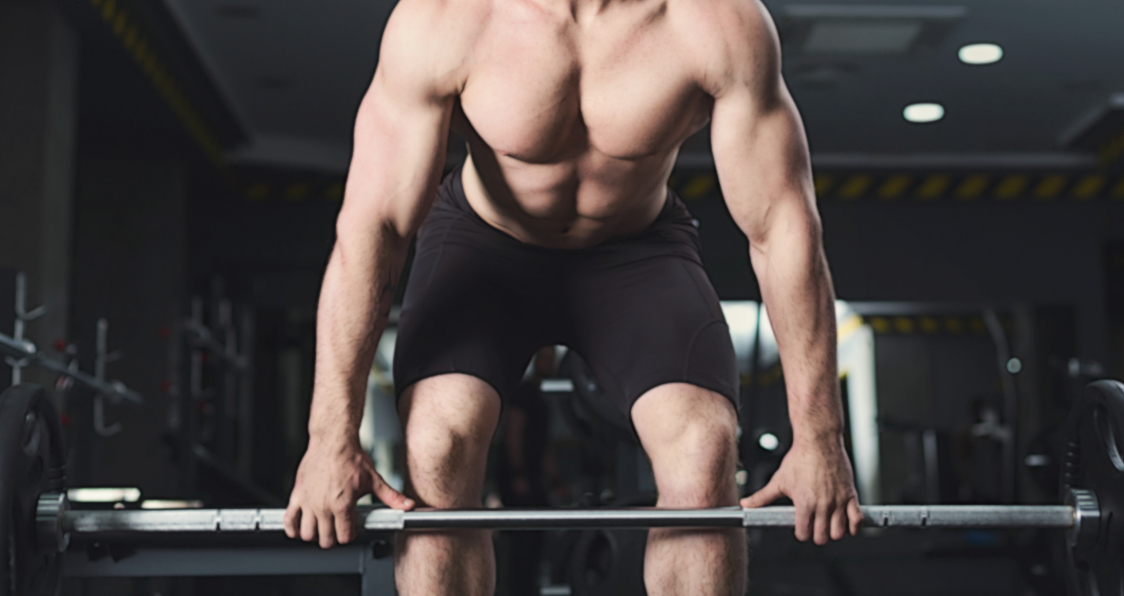
Partial Reps for Strength, Size, and Performance
The rack pull is a variation of the deadlift which involves restricting the range of motion by starting with the barbell on the racks rather than pulling from the floor.
The exercise is commonly used for improving pulling ability and for building strength in many posterior muscles such as the glutes, traps, and lats.
The rack pull is an excellent choice for beginners as it teaches the performer the correct position for a deadlift and perfects the hip hinge movement.
This article will show you how to rack pull effectively, review the benefits of the exercise and provide a variety of rack pull progressions and alternatives.
Performing the Rack Pull in 3 Simple Steps
If executed correctly, the rack pull is a fantastic posterior chain developer. However, performing it with poor technique or with an excessively heavy load can lead to ineffective movement and injury.
To perform the perfect rack pull, follow the below 3 steps.
Step 1
Start by adjusting the pins on the squat rack or lifting cage so that the bar is off the floor. Ideally, you want to start with the bar at your lockout sticking point.
If this point is above the knee, align the bar with the lower thigh; if it is beneath the knee, drop the pins so that the bar starts slightly under the knee.
Once you have determined the right height, stick with it. Look to add weight to the bar to increase the challenge of the exercise rather than dropping the pins to increase the range of motion.
Step 2
Assume the same stance and grip that you would normally use in a full deadlift. If you’ve never conventionally deadlifted before, start with feet under the hips and hands at shoulder-width on the bar.
Before you lift the bar off the rack, it is crucial that you engage the lats, rhomboids, and abdominals in order to keep the bar close to the body and simultaneously protect the spine.
Therefore, squeeze these muscles as tightly as possible and take a deep breath before you lift. Instead of focusing on simply picking up the bar, concentrate on driving the feet through the floor.
As the bar rises, concentrate on a powerful hip drive at the top of the movement. The rack pull is designed to load the hips to a greater degree than a conventional deadlift.
Step 3
Once you have risen up and are standing fully upright, maintain tension through the trunk muscles and hold the bar in place for a second before returning it to the pins.
This will not only help to develop neuromuscular control and core activation, but it may also have a positive impact on grip strength.
If you want to develop your grip strength even further, consider holding this phase for even longer.
Once the hold has been completed, reverse the movement by pushing the hips backward and drop the bar back to the pins.

The Benefits Of The Rack Pull
This section will focus on a number of benefits associated with regularly performing the rack pull and highlight why exactly it is such an effective exercise.
1) Enhancing Pulling Capacity
As reflected on the rack pull is an excellent developer of pulling strength, grip strength, and neuromuscular control.
In addition, a range of rack pull variations exist, such as conventional, sumo & trap bar, which can be used in order to accelerate gains further.
The rack pull is a superb addition to any deadlifting program as it effectively loads the glutes, back & traps to bring about changes in muscle strength & size as well as developing grip strength.
A combination of these things can lead to improved performance with the deadlift.
2) Reduced Lumbar Loading
The rack pull tends to place less stress on the lower spine; this is because the trunk tends to be slightly more vertical in the rack pull than during the conventional deadlift.
This alteration in trunk orientation places less stress on the spinal erectors and lumbar (lower) spine – this is also the case with the sumo deadlift (1).
While it is important that the lower back is targeted frequently in order to enhance strength, performance and general health (2), there are occasions where you may want to use the rack pull.
For example, with all training, it is necessary to decrease training volume at times to allow the body to optimally recover and adapt.
In preparation for an event or competition, there may also be a need to reduce lower back loading yet still work with heavy weights to ensure that you are suitably prepared.
3) Trapezius and Back Development
As mentioned, a rack pull is simply the top portion of the deadlift which involves a limited range of motion. Because of this, heavier weight can be lifted and demand increased.
The rack pull works a range of posterior chain exercises – in particular, the trapezius and back muscles (including the lats, rhomboids, and spinal erectors).
Because the trunk is slightly more upright, the glutes, hamstrings, and quads are not as heavily recruited as they are in a full deadlift; as a result, the traps and back muscles are subject to more stress.
When a great amount of mechanical tension is placed on muscles, the muscles may increase in size (3). Therefore, rack pulls can efficiently develop trap and back size & strength.
4) Building Grip Strength
For many lifters, grip strength can prove problematic – especially when it comes to heavy deadlifts.
As reflected on the rack pull is a great choice for improving grip strength. Once again, the limited range in the pull allows for more weight to be lifted which increases the need for a strong grip.
With regular training at supramaximal loads, neurological and strength changes will occur thus facilitating an improvement in overall grip strength.
Building grip strength will more effectively ready you for heavy deadlifts and can even contribute towards maintaining a neutral spine throughout the course of the exercise.

Rack Pull Variations
There may be times in your training where you must either regress, progress or find an alternative.
Below you will find a variety of rack pull progressions and alternatives to match your training goals, needs, and experiences.
Progressions:
Reverse Band Rack Pulls
This progression will allow you to lift an even greater load through the use of a strong resistance band attached from an overhead point and around the bar.
The band will initially assist in lifting the bar from the pins, however, as the bar rises up this assistance decreases which forces the lifter to generate maximal power.
Rack Pull with Accommodating Resistance
Accommodating resistance in the form of chains and bands can increase the challenge of the rack pull and enhance lower back activation (4).
Using accommodating resistance increases the need for maximal force production throughout the entirety of the exercise which can bring about significant changes in strength.
Fat Bar Rack Pulls
For those who struggle with grip strength, a fat bar (or axle bar) may be a useful tool. The thicker diameter makes the bar harder to grip thus facilitating improvements in grip strength.
Isometric Rack Pulls
For the isometric pull, place the bar underneath the pins (not on top). The idea with this exercise is to pull the bar upward until it makes contact with the bottom side of the pins.
The lifter should pull as hard as possible at this point while maintaining maximal muscular engagement. Isometric exercises can help to build strength and enhance neuromuscular control.

Alternatives:
Trap Bar & Sumo Deadlift
As reflected on the rack pull places the trunk in a more upright position than the conventional deadlift. The trap bar and sumo deadlift likewise place the trunk in this position.
As with the rack pull, some individuals find that it is possible to lift supramaximal loads with the trap bar and therefore may experience greater strength and size gains.
In a similar way, the sumo deadlift has a shorter range than a conventional deadlift due to the wide stance that is assumed. Therefore, this may also allow for significant weight to be lifted.
Lastly, the sumo deadlift makes the perfect exercise choice for those who are struggling with strength or movement issues.
Deadlift from Blocks
The bar does not have to be placed on the pins in order to perform a rack pull – elevating the bar by placing it on blocks does the same job.
In general, the demands placed on the body while deadlifting from the blocks are similar to pulling from the rack. Both use a restricted range of motion which may help you move beyond any sticking point.
Final Word
For accelerating the rate of posterior chain and grip development, the rack pull should be considered due to the restricted range of motion, muscle activation, and supramaximal loads.
The exercise can prove to be useful for the majority of lifters however, it may be particularly useful for beginners, those who are working around restrictions and for those who have reached a strength plateau.
Let us know what you think in the comments below. Also, be sure to follow Generation Iron on Facebook, Twitter, and Instagram.
*Images courtesy of Envato
References:
1-Cholewa, Jason M.; Atalag, Ozan; Zinchenko, Anastasia; Johnson, Kelly; Henselmans, Menno (2019-9). “Anthropometrical Determinants of Deadlift Variant Performance”. Journal of Sports Science & Medicine. 18 (3): 448. PMID 31427866.
2-Schellenberg, Florian; Taylor, William R.; Lorenzetti, Silvio (2017). “Towards evidence based strength training: a comparison of muscle forces during deadlifts, goodmornings and split squats”. BMC Sports Science, Medicine and Rehabilitation. 9. doi:10.1186/s13102-017-0077-x. PMID 28725437.
3-pubmeddev; BJ, Schoenfeld. “The mechanisms of muscle hypertrophy and their application to resistance training. – PubMed – NCBI”. www.ncbi.nlm.nih.gov.
4-Andersen, Vidar; Fimland, Marius S.; Mo, Dag-Andrè; Iversen, Vegard M.; Larsen, Tommy M.; Solheim, Fredrik; Saeterbakken, Atle H. (2019). “Electromyographic comparison of the barbell deadlift using constant versus variable resistance in healthy, trained men”. PLoS ONE. 14 (1). doi:10.1371/journal.pone.0211021. PMID 30668589.
